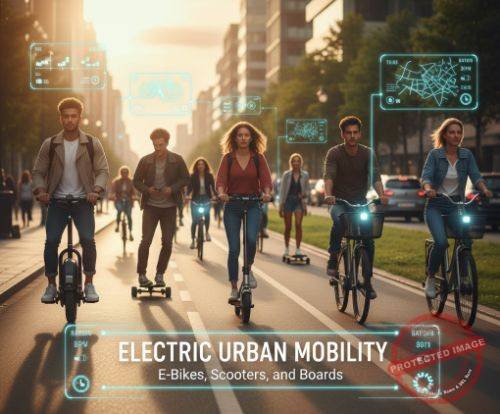From Commute to Culture—How Electric Personal Transport Is Redefining the Way We Move Through Cities.
The Electric Revolution on Two (and Four) Wheels
Cities around the world are transforming. As congestion, pollution, and fuel costs rise, millions are turning to electric personal transport—from e-bikes and scooters to skateboards and compact EVs.
What began as an alternative to cars has evolved into a movement for cleaner, faster, and smarter urban mobility. These devices represent freedom reimagined: lightweight, connected, and powered by innovation rather than combustion.
In 2025, personal electric mobility isn’t just a trend—it’s becoming the core of urban transportation strategy worldwide.
Micromobility Takes the Lead
The term micromobility encompasses all small, lightweight, electric vehicles designed for short-distance travel. E-bikes and e-scooters dominate this segment, reshaping the daily commute for millions.
Key advantages driving adoption include:
-
Efficiency: Quick, low-cost transport for urban environments.
-
Sustainability: Zero emissions and reduced carbon footprint.
-
Accessibility: Easy to use, store, and maintain.
-
Convenience: Freedom from parking limitations and traffic jams.
According to McKinsey, micromobility could account for up to 25% of urban travel by 2030—a monumental shift in how cities are planned and experienced.
Technology Behind the Movement
Today’s electric mobility gadgets are powered by advanced engineering and smart connectivity.
-
Lithium-ion and solid-state batteries provide longer range and faster charging.
-
Regenerative braking systems improve energy efficiency.
-
Integrated GPS and IoT sensors track performance, theft, and location data.
-
AI-powered control systems adapt to user riding style and terrain.
-
Mobile apps manage routes, diagnostics, and sharing options.
These innovations make personal transport not only eco-friendly but intelligent, giving riders real-time data and safety insights at their fingertips.
Urban Mobility Meets Smart Infrastructure
Electric personal transport thrives where smart city infrastructure supports it.
Cities are integrating:
-
Dedicated bike and scooter lanes for safety and flow.
-
Smart traffic signals that prioritize green transport.
-
Public charging hubs powered by renewable energy.
-
Shared mobility platforms for seamless access via smartphone apps.
This ecosystem transforms mobility from a personal convenience into a public asset, aligning with global sustainability goals and urban redesign initiatives.
Safety and Regulation: Balancing Innovation and Responsibility
The rise of e-bikes and scooters has also brought new challenges—chief among them, safety and regulation.
Governments are introducing policies for:
-
Helmet mandates and speed limits.
-
Shared mobility fleet management.
-
Battery recycling and safety standards.
-
Insurance and licensing frameworks.
Technology is stepping in, too. AI-powered safety systems detect collisions, monitor rider behavior, and alert emergency services when needed.
The key to sustained adoption lies in harmonizing innovation with accountability.
Culture Shift: Mobility as a Lifestyle
Beyond transportation, electric personal mobility has become part of a cultural shift toward freedom, wellness, and environmental consciousness.
Urban professionals use e-bikes for daily commutes. Students and tourists rent scooters to explore cities sustainably. Even adventure seekers are embracing electric skateboards and hoverboards as lifestyle accessories.
What once symbolized convenience now represents identity—a declaration of mobility that’s mindful, modern, and electric.
Sustainability and the Circular Economy
Electric mobility gadgets are central to the fight against climate change. Each kilometer traveled by e-bike instead of car reduces emissions by nearly 90%.
The next frontier is sustainability at scale:
-
Battery recycling programs minimize waste and environmental impact.
-
Lightweight materials improve energy efficiency.
-
Shared mobility systems reduce manufacturing demand.
In combination with renewable energy and smart grids, these innovations form the foundation of carbon-neutral urban transport ecosystems.
Closing Thoughts and Looking Forward
Electric personal transport represents more than just a cleaner commute—it’s a reinvention of urban freedom. As cities grow denser and digital ecosystems more integrated, mobility will continue evolving toward personalized, connected, and autonomous solutions.
Tomorrow’s streets will hum with silent efficiency—powered not by engines, but by electricity, intelligence, and imagination.
The age of mobility gadgets has arrived—and the city of the future will ride on their wheels.
References
-
“Micromobility’s Impact on Urban Transport” – World Economic Forum
https://www.weforum.org/agenda/2024/06/micromobility-impact-on-urban-transport -
“E-Bikes and Electric Scooters: Powering Sustainable Cities” – McKinsey & Company
https://www.mckinsey.com/industries/automotive-and-assembly/our-insights/e-bikes-and-electric-scooters-sustainable-cities -
“Smart Infrastructure for Connected Mobility” – Deloitte Insights
https://www.deloitte.com/insights/smart-infrastructure-for-connected-mobility -
“Battery Innovation and the Future of Electric Transport” – MIT Technology Review
https://www.technologyreview.com/2024/10/11/battery-innovation-electric-transport -
“Safety and Regulation in the Age of Micromobility” – Forbes Tech Council
https://www.forbes.com/sites/forbestechcouncil/2024/09/23/safety-and-regulation-in-the-age-of-micromobility
Author: Serge Boudreaux – AI Hardware Technologies, Montreal, Quebec
Co-Editor: Peter Jonathan Wilcheck – Miami, Florida
Post Disclaimer
The information provided in our posts or blogs are for educational and informative purposes only. We do not guarantee the accuracy, completeness or suitability of the information. We do not provide financial or investment advice. Readers should always seek professional advice before making any financial or investment decisions based on the information provided in our content. We will not be held responsible for any losses, damages or consequences that may arise from relying on the information provided in our content.



